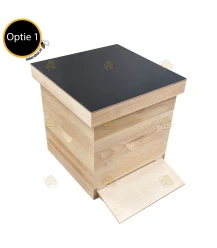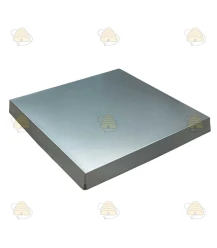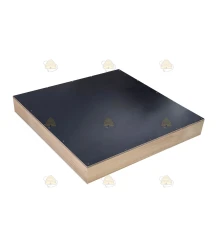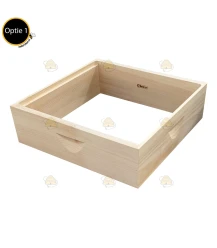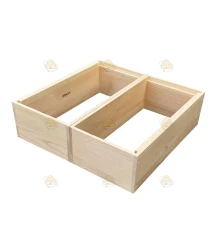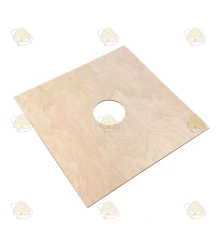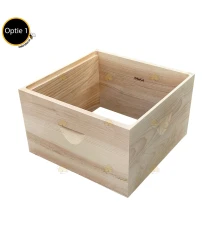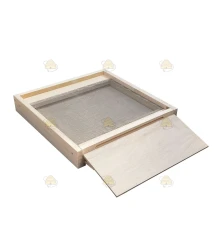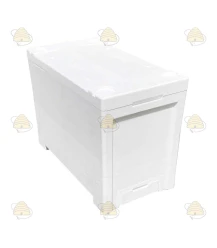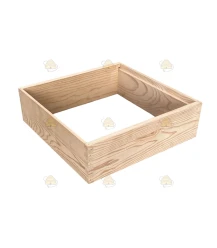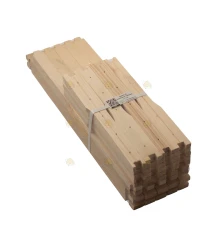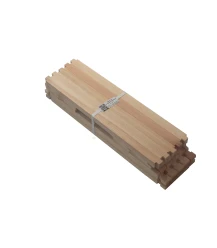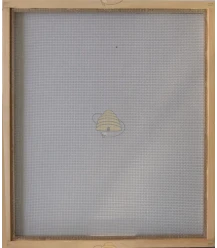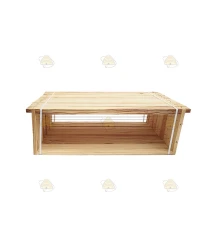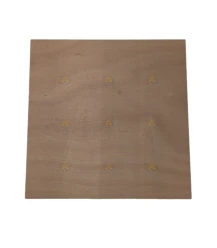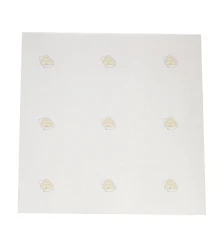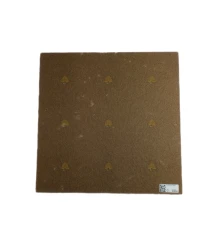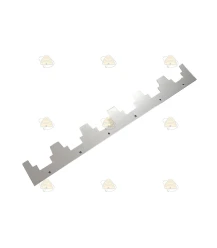Dadant US beehives
Looking to buy a new beehive? Then be sure to consider a Dadant beehive, such as the Dadant-Blatt or the Frankenbeute Dadant US. A Dadant US or Dadant US beehive, with its spacious design and proven efficiency, can be a valuable investment for any beekeeper, whether you’re just starting out or have kept bees for years.
Hives in the Dadant US size are designed so the colony can be maintained on a single brood box (brood chamber). One or two honey supers are then often added above the colony. The footprint of the brood box (brood chamber) and honey super is 50.9 x 50.9 cm. A Dadant US beehive holds 12 hive frames. You can choose to position the frames using spacing strips, or hang them 'loose' in the hive using Hoffmann frames. (It is also possible to work with 10 frames.)
-
Beehive Dadant US pine Premium (1 brood box, 1 honey super) BeeFun®
€ 177,60 In stock and available for immediate delivery.Dadant US pine beehive by BeeFun®. This beehive in the Dadant US frame size is made from Premium pine timber and has finished corners to prevent moisture ingress. You won’t easily find a better pine beehive! The wood thickness of the hive is approx. 2.3 cm. The external dimensions of the hive are approx. 51 cm by 51 cm. The roof overlaps and therefore...View more -
Metal roof cover Dadant US, internal dimensions 56,5 x 56,5 cm
€ 23,50 In stock and available for immediate delivery.Metal roof cover for covering the wooden roof of your Dadant US beehive or for replacing the roof covering of your hive. The internal dimensions of the roof cover are 56.5 x 56.5 cm. The corners are welded shut.View more -
Roof Dadant US Premium pine BeeFun®
€ 29,95 In stock and available for immediate delivery.Pine roof for the Dadant US beehive, made from premium-quality pine. Looking for roof covering for this roof? Then check out the product [product id=4083]Metal roof cover Dadant US, internal size 56.5 x 56.5 cm (item no. 6675)[/product].View more -
honey super Dadant US Premium pine BeeFun®
€ 43,30 In stock and available for immediate delivery.Dadant US honey super, made of Premium-quality pine wood. These Premium beehive components are manufactured in the EU. The honey super is neatly finished at the corners so moisture cannot seep into the wood. Choose from 3 options: Option 1 consisting of:- Dadant US Premium pine honey super BeeFun® Option 2 consisting of option 1 + :- [product...View more -
Half-depth honey super set Dadant US Premium pine BeeFun®
€ 48,10 In stock and available for immediate delivery.Set of two pine half-depth honey supers for the Dadant US beehive, made from premium-grade pine. Ideal for the beekeeper who doesn’t want to lift heavy loads. By using two half-depth honey supers, the weight is halved. Includes 4 spacer strips for self-assembly.View more -
Crown board Dadant US Premium pine BeeFun®
€ 11,75 In stock and available for immediate delivery.Pine cover board for the Dadant US beehive, made from premium-quality pine. Dimensions: 51 x 51 cm.View more -
Brood box (brood chamber) Dadant US Premium pine BeeFun®
€ 58,80 In stock and available for immediate delivery.Dadant US brood box, made from Premium-quality pine wood. These Premium beehive components are produced in the EU. The brood box is neatly finished at the corners so moisture cannot penetrate the wood. Choose from 3 different options: Option 1 consisting of:- [product id=4512]Dadant US brood box Premium pine BeeFun® (item no. 7107-1)[/product] Option 2...View more -
Bottom board Dadant US Premium pine BeeFun®
€ 46,00 In stock and available for immediate delivery.Pine bottom board for the Dadant US hive, made from premium-quality pine and fitted with a varroa mesh screen. The bottom board comes with an entrance reducer block and a detachable landing board. In addition, this bottom board includes a sliding varroa tray.View more -
Six-frame Dadant US (with rails) EPS nuc box
€ 44,95 In stock and available for immediate delivery.Six-frame Dadant US. A nuc box in Dadant US frame size. The nuc box is made of polystyrene (EPS), the same material used for Segeberger hives. These EPS Dadant boxes are extremely sturdy yet lightweight. The ideal hive for beekeepers who want a lightweight, well-insulated hive and use a larger frame size.View more -
honey super Dadant US (pine)
€ 36,59 € 40,65 In stock and available for immediate delivery.Pine honey super for the Dadant US hive. This pine Dadant US hive is made in the EU! Note: don’t forget to order your [category id=78]frame spacers[/category] if you need them. The honey super is delivered without hive frames. The dimensions of the brood box are 50.5 x 50.5 with a height of 15 cm.View more -
Dadant US brood box Hoffmann frames unassembled pine set
€ 14,25 In stock and available for immediate delivery.Unassembled brood box frames for the Dadant US hive size, which is widely used in the Netherlands. The lugs of these frames are 22 mm wide so they can fit into frame spacers if needed. These frames have 35 mm Hoffman sides, making it possible to work without frame spacers. The frames, including lugs, are 482 mm wide, the bottom of the frame is 448 mm...View more -
Dadant US honey super Hoffmann frames (141 mm) unassembled pine set
€ 14,25 In stock and available for immediate delivery.10 unassembled honey super hive frames for the Dadant US hive size, which is widely used in the Netherlands. The lugs of these frames are 22 mm wide so they fit neatly in spacing strips. These frames have 35 mm Hoffman side bars, making it possible to work without spacing strips. The frames including lugs are 482 mm wide, the bottom bar is 448 mm wide and...View more -
Escape board travel screen Dadant US 50.9 x 50.9 cm
€ 15,85 In stock and available for immediate delivery.This Dadant travel screen provides effective ventilation to prevent overheating, is framed, and is available for Dadant hives measuring 50.9 x 50.9 cm. Also known as a travel screen, separator, or uniting board.View more -
Dadant US honey super hive frames assembled 141 mm pine (per 10 pcs.)
€ 17,95 In stock and available for immediate delivery.Set of 10 assembled Dadant US honey super hive frames. The frames have a height of 141 mm. They are neatly finished, wired with stainless steel wire, and fitted with eyelets. Packed per set of 10.View more -
Dadant US brood box Hoffmann frames assembled 285 mm pine (per 10 pcs.)
€ 19,95 In stock and available for immediate delivery.Dadant US assembled brood box Hoffmann frames with a height of 285 mm, horizontally wired in a pack of 10. These frames, with a 481 mm top bar, are made from high-quality pine. The frames are fitted with four horizontal 0.4 mm stainless steel wires and brass eyelets to prevent corrosion during formic acid treatments. Furthermore, the frames are knot-free,...View more -
Inner cover Dadant US (pine) 10 mm
€ 16,00 This product is ordered, delivery time is approximately 2-4 days.Cover board for the pine Dadant US beehive. Ideal as an extra cover board. Made of nicely flat waterproof plywood, 10 mm thick. Ideal for this large beehive. The dimensions of this Dadant cover board are 50,5 x 50,5 cm.View more -
Dadant US plastic crown board 50.9 x 50.9 cm
€ 6,75 In stock and available for immediate delivery.Plastic cover board suitable for the Dadant US beehive. The dimensions are approximately 50.9 x 50.9 cm. Made from 1 mm thick transparent plastic so you can look through it without disturbing the bees. Tip: remove any protective film before use and do not place a plastic cover board unprotected in direct sunlight.View more -
-
Castellated spacer 6-frame for Dadant US half-super aluminium (each)
€ 0,99 In Stock6-frame spacer strip, suitable for a half-size Dadant US hive. This strip is made of aluminium. The spacer strip is suitable for, for example, product [product id=4514]#7109 Half honey super set Dadant US[/product] Note: the price is per piece and the spacer strip is supplied without small nails. Tip: [product id=1051]special thin nails[/product] for the...View more -
Dadant US honey super Hoffman hive frames assembled 159 mm pine (pack of 10)
€ 13,95 In stock and available for immediate delivery.Dadant US assembled honey super Hoffmann frames with a height of 159 mm, horizontally wired, in a pack of 10. These frames, with a top bar of 481 mm, are made from high-quality pine. The frames are fitted with four horizontal stainless steel wires of 0.4 mm, and brass eyelets to prevent corrosion during formic acid treatments. Furthermore, the frames are...View more
A Cornerstone of Modern Beekeeping
The Dadant US beehive (also known as Dadant US or Dadant US beehive) is renowned worldwide for its practical design and efficiency. Originally developed by Charles Dadant in 1863, this wooden beehive is a favorite among both hobbyists and professional beekeepers. Its beekeeper- and bee-friendly construction makes it an ideal choice for anyone looking to buy a beehive.
The Legacy of Charles Dadant
Charles Dadant, a French immigrant to the United States—hence the name Dadant US beehive, where US stands for United States—transformed beekeeping by improving the design of the Langstroth beehive. With larger brood boxes (brood chambers) and spacious honey supers (supers), he emphasized maximum honey production and a healthy bee colony. Over the years, various models emerged, such as the Dadant-Blatt beehive, which is widely used in Europe.
Innovative design for efficient beekeeping
The design of the Dadant US beehive is characterized by a two-part structure with a brood box (brood chamber) and one or more honey supers. This allows inspections and harvesting honey without disturbing the brood, simplifying colony management. You also don’t need to lift heavy brood boxes (brood chambers) off each other during inspections. A notable variant is the Frankenbeute Dadant US, made of expanded polystyrene (EPS). This version offers excellent insulation and durability. The required hive frames and beeswax foundation for a Dadant beehive are available in various cell sizes to meet the needs of the beekeeper and the colony.
Choosing the right materials
Material choice for a Dadant US beehive is critical to performance. Wood (such as red cedar) is praised for its natural resistance to rot and good insulating properties. Pine is also popular due to its affordability, although it often requires a bit more maintenance. Other softwoods can be used, but generally demand extra care. Expanded polystyrene is gaining popularity thanks to its light weight and excellent insulation, while plastic hives require less maintenance, they are less natural than a wooden Dadant US beehive.
Advantages of the Dadant US
One of the key advantages of choosing a Dadant US (Dadant US beehive) is the large brood box (brood chamber). This allows beekeepers to keep strong colonies without needing multiple brood boxes (brood chambers). It promotes natural colony expansion, increases productivity, and reduces stress on the bees. Due to its larger dimensions and higher capacity, the Dadant US beehive is particularly suitable for commercial beekeeping, where high honey yield is important. Managing one large brood box (brood chamber) also saves time and effort compared with multiple smaller boxes.
Points to consider
Despite the many advantages, there are also some challenges associated with the Dadant beehive. Full brood boxes (brood chambers) and honey supers can be quite heavy, which can make harvesting demanding. Weight is often seen as a drawback—both from the large hive frames and from the hive itself. However, if you keep the hive in a fixed location, choosing a Dadant US beehive is certainly worth considering.
Essential components of the Dadant US beehive
A standard Dadant US beehive consists of several important components, including the brood box (brood chamber), honey supers, bottom board, inner cover, and a roof or outer cover often made of galvanized steel. The queen and brood are housed in the brood box (brood chamber), while the honey supers are used exclusively for honey storage. The bottom board with landing board provides stability and serves as the entrance for the bees, and the outer cover protects against the weather. If needed, a feeder can be added for supplemental feeding after the honey harvest or to boost a colony.
Dimensions and capacity
The standard dimensions of a Dadant US beehive are approximately 509 mm by 509 mm. The brood box (brood chamber) frames are about 48.2 cm long and 28.5 cm high (including lugs), and there is room for up to 12 hive frames. There are also hives that hold 10 frames; these are narrower, and of course there are 6-frame nucs such as our EPS range. These generous dimensions provide ample space for colony growth and honey storage.
Dadant US vs. Dadant-Blatt
Although the Dadant US beehive is used mainly in North America and parts of Western Europe, the Dadant-Blatt is more popular in Europe. The designs are very similar, but differences in the size of the hive frames mean they are not fully interchangeable. The Dadant-Blatt is designed to minimize beekeeper intervention and offers a more efficient way of management, which many beekeepers appreciate.

